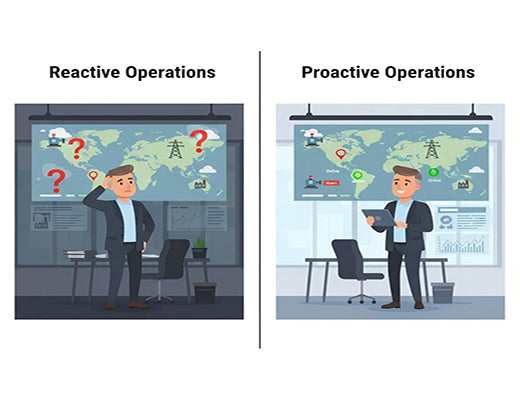
What is IoT Monitoring? A Beginner's Guide to Remote Asset Management
|
|
Time to read 5 min
|
|
Time to read 5 min
IoT monitoring is the use of internet-connected sensors and devices to collect real-time data from physical assets—like machines, equipment, and infrastructure—allowing businesses to view their status and manage them remotely from a central dashboard. A complete remote monitoring system consists of sensors to gather data, a gateway to transmit it, and a cloud platform to analyze and display it. This technology is revolutionizing industries by enabling a proactive approach to maintenance, reducing costly downtime, and dramatically improving operational efficiency.
IoT monitoring transforms business operations from reactive to proactive by providing 24/7, real-time visibility into the health and status of your remote assets.
The primary business benefits are reducing costly downtime, improving operational efficiency by eliminating unnecessary site visits ("truck rolls"), and enabling new services like predictive maintenance.
A complete IoT monitoring solution consists of four key components: Sensors (the senses), a Gateway (the nervous system), a Cloud Platform (the brain), and the Application (the dashboard).
The industrial router or gateway is the critical communication hub that ensures reliable and secure data transmission from the field to the cloud, making it the backbone of any professional system.
I was talking to the operations manager of a regional water utility. They had hundreds of pumps and valve stations spread across a massive, rural county. Their biggest operational headache? "I have no idea what's happening at a site," he said, "until a customer calls to complain that their water is out. Then I have to send a technician on a two-hour drive just to find out a pump has failed."
This is the classic "black box" problem that plagues any business with distributed assets. You are blind to a problem until it's already a crisis.
Let's be clear: there is a solution that gives you eyes and ears on every single asset, 24/7. That solution is IoT monitoring. This guide will break down what it is, why it matters, and how it works.
Every professional IoT monitoring solution, whether it's tracking a single generator or a thousand vending machines, is built with these four essential blocks.
This is the central software hub where all the data from all your gateways is sent. A cloud platform performs two key jobs:
This is the final piece of the puzzle—the user interface where raw data is turned into valuable insight. It's the web or mobile dashboard where you can see your pump statuses on a map, view historical temperature graphs, and receive critical alerts.

IoT monitoring is one of the most powerful and accessible technologies available to businesses today. It's a practical solution that replaces guesswork with real-time data, and reactive firefighting with proactive management.
By understanding the core components and, most importantly, by building your system on a foundation of secure and reliable connectivity, you can break open the "black box" of your remote operations and unlock a new level of efficiency, resilience, and intelligence for your business.
Further Reading:
A Practical Guide to IoT Remote Temperature MonitoringChoosing the Right Router for Your IoT Monitoring SystemWhy You Need a Cloud Platform for IoT Monitoring at Scale
A1: It has become much more accessible. Many companies now offer "all-in-one" solutions or starter kits that bundle pre-configured sensors and gateways. While some technical knowledge is helpful, you no longer need to be a deep expert in every layer of the technology to get started.
A2: The cost can range from a few hundred dollars for a single-point solution to many thousands for a large-scale industrial deployment. The key is to analyze the Total Cost of Ownership (TCO) and compare it to the ROI. Often, preventing just one major equipment failure or eliminating a few dozen "truck rolls" can pay for the entire system.
A3: While all four components are necessary, the connectivity gateway is often the most critical link in the chain. The entire system's reliability and security depend on the gateway's ability to maintain a stable connection and protect the data it transmits. Choosing a professional, industrial-grade gateway is the most important decision you will make.